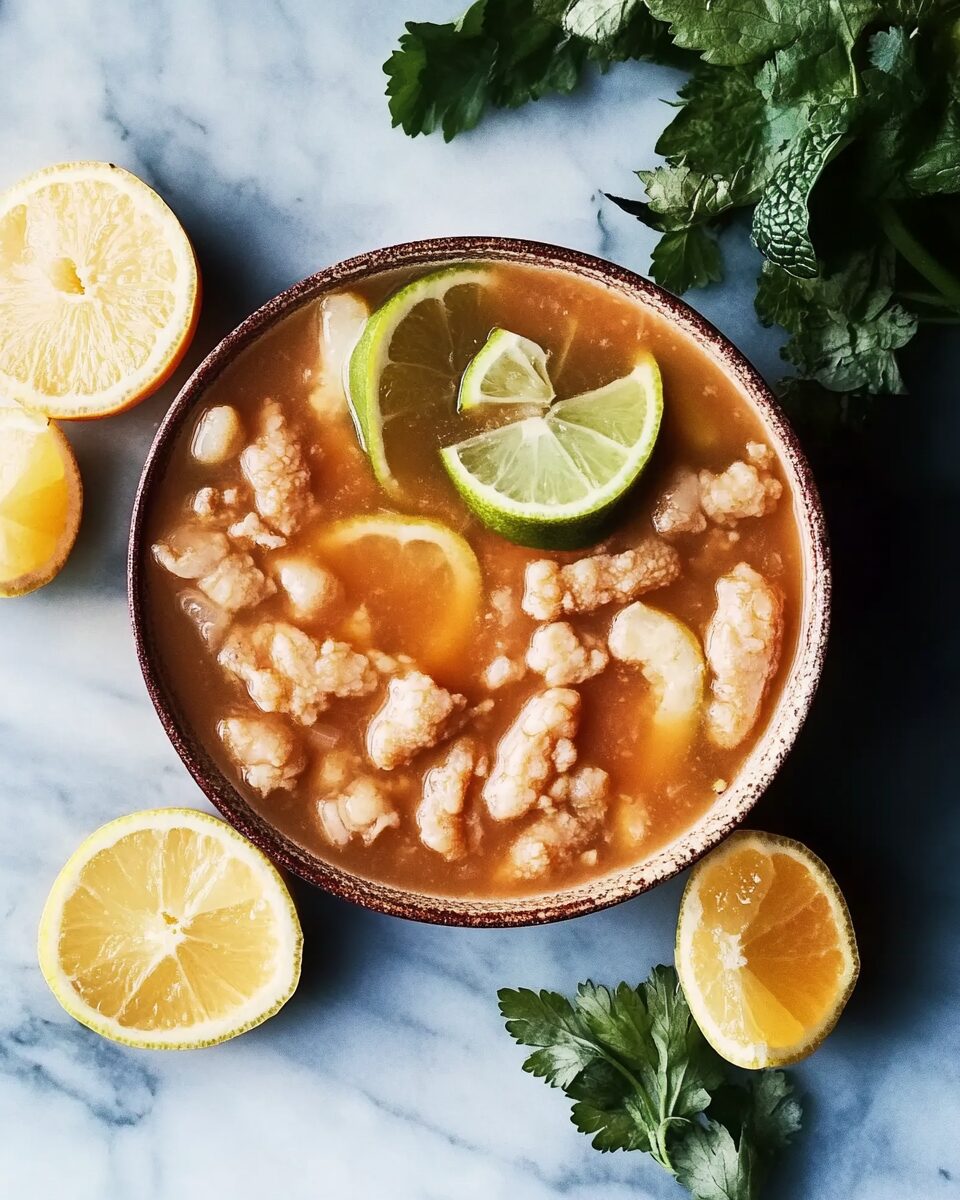Menudo Rojo, or Red Menudo, is a traditional Mexican soup renowned for its rich, spicy broth and hearty ingredients. Often enjoyed during special occasions and touted as a remedy for hangovers, this dish combines tender beef tripe with hominy and a blend of flavorful chilies. Garnished with fresh cilantro, onions, and lime, Menudo offers a comforting and authentic culinary experience.
Full Recipe:
Ingredients
Soup:
- 2 ½ pounds beef tripe, cut into 1-inch pieces
- 1 gallon water
- 1 large white onion, finely chopped
- 6 cloves garlic, finely chopped
- 2 tablespoons ground red pepper
- 1 ½ tablespoons dried oregano
- 1 ½ tablespoons salt
- 1 tablespoon ground black pepper
- 5 de árbol chile peppers
- 6 japones chile peppers, seeds removed
- 6 cups canned white or yellow hominy, drained
Garnishes:
- ¼ cup chopped fresh cilantro
- ½ medium white onion, chopped
- 8 lime wedges
Directions
-
Prepare the Tripe:
In a large pot, bring water to a boil. Add the tripe, reduce heat, and simmer for 2 hours, skimming off fat periodically. Drain and refill the pot with fresh water. Simmer for another 2 hours and drain again. -
Cook the Soup:
Pour 1 gallon of water over the tripe in the pot and bring to a boil. Stir in the chopped onion, garlic, ground red pepper, oregano, salt, and black pepper. Reduce heat and simmer for 1 hour. -
Add Chilies and Hominy:
While the soup simmers, heat a skillet over medium-high heat. Toast the de árbol and japones chile peppers until fragrant, about 2 minutes. Place toasted chilies in a bowl, cover with hot water, and let soak until softened, approximately 20 minutes. Drain and puree the chilies in a blender until smooth; add water as needed to achieve a smooth consistency. Stir the chili puree and hominy into the soup. Continue to simmer until flavors meld, about 1 hour more. -
Serve:
Ladle the menudo into bowls. Serve hot, garnished with chopped cilantro, chopped onion, and lime wedges.
Nutrients
Per serving (approximate):
- Calories: 225
- Total Fat: 5 g
- Saturated Fat: 0 g
- Cholesterol: 139 mg
- Sodium: 1,679 mg
- Total Carbohydrates: 32 g
- Dietary Fiber: 6 g
- Sugars: 0 g
- Protein: 14 g
Historical Roots of Menudo
Menudo’s origins can be traced back to colonial Mexico, a time when Spanish influence began to transform Indigenous culinary practices. During this era, Spanish colonizers introduced the practice of using every part of the animal — nose-to-tail eating — to Indigenous groups. Beef tripe, the stomach lining of cattle, was one such byproduct that found its way into communal meals out of necessity rather than preference.
The combination of this offal with traditional Mesoamerican ingredients such as maize (hominy), chili peppers, and aromatic herbs birthed an early version of what we now call Menudo. In rural regions and among poorer families, resourcefulness and respect for the animal led to recipes that celebrated every edible part. Menudo, therefore, emerged as a product of survival, resilience, and culinary ingenuity.
Over generations, this once humble dish became a source of pride. It was no longer a food born only of scarcity, but one that was lovingly prepared and handed down as part of family traditions. Each region adapted the base recipe, adding its own flare and emphasis on certain ingredients. The red chili paste found in Menudo Rojo, for example, is most associated with northern Mexico, while other regions developed their own renditions.
Cultural Significance
In Mexican culture, food is more than sustenance; it is an expression of love, heritage, and social connection. Menudo Rojo, in particular, holds a ceremonial status. It’s not the kind of dish you whip up quickly on a weekday evening. Instead, it’s a commitment — a dish that often takes six to eight hours to prepare, requiring patience and intention.
Because of its intensive preparation, Menudo Rojo is typically reserved for special occasions such as weddings, baptisms, birthdays, and major holidays like Christmas and New Year’s Day. It is also a classic Sunday brunch staple, especially after a night of celebration. For many families, making menudo is a group activity — someone cleans the tripe, another prepares the chili paste, and others handle the garnishes and tortillas. This collective preparation process strengthens family bonds and creates lasting memories.
Menudo also has its place in popular culture. In Mexico and among the Mexican diaspora in the U.S., you’ll find countless roadside restaurants, food trucks, and family-owned eateries boasting “the best Menudo in town.” It has become a test of culinary credibility for many cooks, similar to gumbo in the southern United States or ramen in Japan.
Symbolism and Tradition
The dish represents more than flavor; it symbolizes identity and belonging. For Mexican-Americans, Menudo Rojo is often the taste of home. It’s a dish that evokes memories of grandparents cooking in the early morning hours, the scent of simmering broth filling the house, and a sense of continuity with generations past.
It’s also closely associated with resilience. The transformation of an organ meat — often considered unpalatable — into a delicacy is a metaphor for making the best of one’s circumstances. This resourcefulness resonates deeply with immigrant and working-class narratives.
In rural areas, many families still prepare menudo over wood fires in massive clay or metal pots, a tradition that spans centuries. Community gatherings around these pots aren’t just meals; they’re cultural reenactments of ancestry, love, and survival.
Regional Variations
As with many iconic dishes, there isn’t a single “authentic” way to make Menudo Rojo. It varies by region, availability of ingredients, and family traditions.
-
Northern Mexico tends to favor red menudo (Rojo), which is made with a robust chili base using dried guajillo or ancho chilies. Hominy is commonly included, giving the soup a chewy texture that contrasts nicely with the tender tripe.
-
Central Mexico often refers to menudo as “pancita.” Here, the broth may include additional spices like cloves or cinnamon for a more aromatic flavor. Hominy is less common, and lime is more heavily used to brighten the flavor.
-
Southern Mexico and Yucatán Peninsula feature a variation known as “mondongo.” While similar, mondongo can include pig’s feet and other organ meats, and the flavor base may include tomato or sour citrus, giving the dish a different kind of tanginess.
-
The Southwestern United States, with its large Mexican-American population, has developed its own spins. Canned hominy, pre-cleaned tripe, and quick-prep chili pastes have become commonplace in these versions, adapting the traditional dish to modern lifestyles without compromising its essence.
Each variation is valid and deeply loved, reflecting the adaptability and regional diversity within Mexican cooking.
Health Considerations
Menudo Rojo, while rich in cultural and emotional significance, also offers a variety of health benefits when consumed in moderation.
Tripe is high in protein and low in fat, making it a surprisingly lean source of animal protein. It also contains important micronutrients like vitamin B12, zinc, and selenium. These support everything from immune function to red blood cell formation.
Hominy, made from treated corn kernels, provides carbohydrates and fiber. It’s a slow-digesting grain that complements the protein-rich tripe, creating a nutritionally balanced dish when paired with fresh toppings like onions, cilantro, and lime.
The red chili paste used in Menudo Rojo contains capsaicin, a compound in chili peppers known for its anti-inflammatory and metabolism-boosting properties. Garlic and oregano, common in most recipes, add antioxidants and antimicrobial benefits.
However, it’s worth noting that traditional menudo can be high in sodium due to added salt and broth concentrates. As with many traditional foods, enjoying menudo in a balanced diet, possibly adjusting the sodium content to your health needs, is advisable.
Social Healing and Comfort
Menudo Rojo is commonly referred to as a “hangover cure,” and this is more than just folklore. The warm, spicy broth helps rehydrate the body and replenish lost electrolytes. The high protein content can stabilize blood sugar, and the comforting warmth soothes the digestive system. Whether scientifically proven or not, for many, a steaming bowl of menudo on a Sunday morning feels like a spiritual revival.
But the healing nature of menudo isn’t just physical. Sharing this meal with loved ones has a deeply emotional impact. It’s a reminder of where you come from, who you belong to, and what you value. Food like menudo doesn’t just nourish the body; it restores the soul.
Modern Popularity and Evolution
Today, Menudo Rojo is more accessible than ever. Ready-to-eat canned versions, pre-cleaned tripe from butcher shops, and store-bought chili pastes make it possible for even beginner cooks to attempt the dish. Many Latinx restaurants and food trucks in the U.S. include menudo on their weekend menus, often selling out by midday due to its popularity.
There are also numerous cooking shows, online communities, and food blogs dedicated to preserving and evolving the menudo tradition. Vegan and vegetarian versions have even begun to emerge, using mushrooms or textured soy as meat substitutes, proving that the essence of menudo — comfort, community, and bold flavor — transcends ingredients.
Menudo festivals and cook-offs have become common in cities with large Mexican populations. These events are not only culinary showcases but cultural celebrations, filled with music, dancing, and storytelling.
Conclusion
Menudo Rojo is far more than a simple soup. It is a dish steeped in history, enriched by cultural identity, and elevated through ritual and care. From its humble origins in rural kitchens to its beloved status in family celebrations and Sunday brunch tables, menudo stands as a testament to the resilience, creativity, and heart of the Mexican people.






